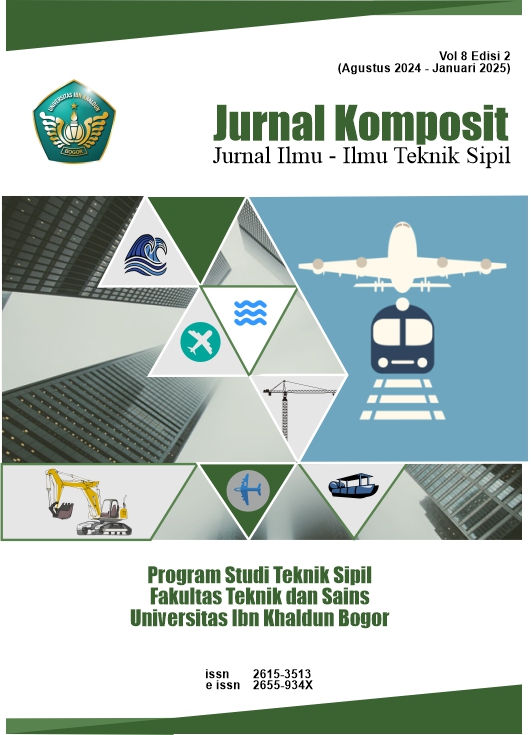Analisis Pekerjaan Beton Bertulang dengan Building Information Modelling (BIM) 5D pada Proyek Pembangunan Kantor dan Pos Jaga Depot Supply Point Pertamina Lubricants Tarakan
DOI:
https://doi.org/10.32832/komposit.v8i2.15893Keywords:
Building Information Modelling (BIM), 5D, COST, VolumeAbstract
The calculation of the cost budget by consultants mostly uses Microsoft Excel. This causes opportunities for errors due to inaccuracies in interpretation and calculation in elaborating the complexity of the building to be built. Calculations that still use excel in development projects where it can result in a much larger calculation difference resulting in cost overruns. For this reason, it is necessary to require more effective cost estimation planning. One of the latest project management information systems today is Building Information Modeling (BIM). BIM has great potential to share visualize information, visualize construction progress, provide information quickly. Therefore, this research uses BIM 5D (Autodesk Revit software) which functions to estimate the cost budget of a project. The Plan Budget Cost (RAB) figure will not be 100% accurate. The purpose of this study is to determine the comparison and difference in volume calculations and RAB using BIM 5D dimensions with calculations of Planning Consultants on Reinforced Concrete Works in the Office and Post Security Depot Supply Point Pertamina Lubricants Tarakan Construction Project. The results of the calculation with BIM 5D method and the Planner Consultant obtained the results of the calculation of the difference where the comparison of the volume of reinforcement is a difference of 3.83% while in concrete work the difference is 4.37%. Meanwhile, the results of the RAB calculation on reinforced concrete work cost difference of 4.10%.
References
Amri, S., Hardyanti, N., & Sumi, S. (2023). Analisis Perbandingan Quantity Take Off (QTO) Beton Menggunakan Metode Building Information Modelling (BIM) dan Metode Konvensional (Studi Kasus: Proyek Kantor PNM Cabang Jember). Jurnal Profesi Insinyur Indonesia, 1, 225-233. Retrieved from http://ejournal.undip.ac.id/index.php/jpii
Arissaputra, S. (2022). Evaluasi Quantity Take Off Pekerjaan Arsitektur Proyek CSR Masjid Jami Medan Satria Menggunakan Autodesk Revit 2020. Technologic. DOI: http://dx.doi.org/10.52453/t.v13i2.421
Dallasega, P., Revolti, A., Sauer, P. C., Schulze, F., & Rauch, E. (2020). Bim, Augmented And Virtual Reality Empowering Lean Construction Management: A Project Simulation Game. Procedia Manufacturing, 49-54. DOI: https://doi.org/10.1016/j.promfg.2020.04.059
Govender, R., Saba, G., Ham, N., Hou, L., Moon, S., & Kim, J.-J. (2019). Appraisal of Building Information Modeling (BIM) Curriculum for Early-Career Construction-Industry pProfessionals: Case Study at C Educational Institute in Korea. International Journal of Contruction Management. DOI: https://doi.org/10.1080/15623599.2019.1661069
Haider, U., Khan, U., Nazir, A., & Humayon, M. (2020). Cost Comparison of a Building Project by Manual and BIM. Civil Engineering Journal, 6. DOI: 10.28991/cej-2020-03091451
Huzaini, S. (2021). Penerapan Konsep Building Information Modelling (Bim) 3D dalam Mendukung Pengestimasian Biaya Pekerjaan Struktur. Universitas Islam Indonesia, 104. Retrieved from file:///C:/Users/user/Downloads/16511230%20Syahrul%20Huzaini%20(1).pdf
Mokolensang, V. M., Arsjad, T., & Malingkas, G. (2021). Analisis Rencana Anggaran Biaya pada Proyek Pembangunan Rumah Susun Papua 1 Di Distrik Muara Tami Kota Jayapura Provinsi Papua. Jurnal Sipil Statik.
Noviani, S. A., Amin, M., & Hardjomuljadi, S. (2021). Metode Building Information Modeling 5D untuk Meminimalkan Klaim Konstruksi yang Ditimbulkan oleh Penyedia Jasa. Jurnal Konstruksia, 29-42. DOI: https://doi.org/10.24853/jk.13.1.29-42
Nugroho, P. S., Latief, Y., Mulyono, B., & Zaman, A. A. (2022). Penggunaan BIM untuk Meningkatkan Keselamatan Kebakaran pada Bangunan Gedung Tinggi. Jurnal Komposit: Jurnal Ilmu-ilmu Teknik Sipil, 29-39. DOI: https://doi.org/10.32832/komposit.v6i1.6738
Setiawan, E. B., & Abma, V. (2021). Penerapan Konsep BIM dari Studi Kasus dan Perspektif Pengguna. Prosiding CEEDRiMS 2021, 269-276.
Sugiyono. (2019). Metode Penelitian Kuantitatif Kualitatif dan R&D. Bandung: Alfabeta Bandung.
Zakaria, Z. B., Nasly, M., Haron, A. T., & Marshall-Ponting, A. (2013). Exploring the adoption of Building Information Modelling (BIM) in the Malaysian construction industry: A qualitative approach. International Journal of Research in Engineering and Technology. doi:http://dx.doi.org/10.15623/ijret.2013.0208060
Downloads
Published
How to Cite
Issue
Section
License
Copyright (c) 2024 Jurnal Komposit: Jurnal Ilmu-ilmu Teknik Sipil

This work is licensed under a Creative Commons Attribution-NonCommercial-ShareAlike 4.0 International License.
Authors who publish with this journal agree to the following terms (Penulis yang mengajukan publikasi artikel telah menyetujui hal berikut):
- Through this publication, the author agree to submit the copyright of article writing to Jurnal Komposit: Jurnal Ilmu-ilmu Teknik Sipil. This copyright submission takes the form of, but is not limited to: reproduction of the article and parts therein, including photographic reproductions; distribution of articles through printed and electronic documents; and translation of articles(Bahwa melalui publikasi ini, hak cipta penulisan artikel diserahkan kepada Jurnal Komposit: Jurnal Ilmu-ilmu Teknik Sipil. Penyerahan hak cipta ini berupa, namun tidak terbatas pada: perbanyakan artikel dan bagian di dalamnya, termasuk reproduksi fotografi; penyebarluasan artikel melalui dokumen cetak dan elektronik; serta penterjemahan artikel).
- The authors agree to the terms of the Copyright Notice, according to Creative Commons Attribution-NonCommercial-ShareAlike 4.0 International License., which will apply to this article if and when it is published by Jurnal Komposit: Jurnal Ilmu-ilmu Teknik Sipil. (Para penulis setuju dengan ketentuan Pemberitahuan Hak Cipta, sesuai dengan Lisensi Internasional Creative Commons Attribution-NonCommercial-ShareAlike 4.0., yang akan berlaku untuk artikel ini jika dan ketika diterbitkan oleh Jurnal Komposit: Jurnal Ilmu-ilmu Teknik Sipil).

This work is licensed under a Creative Commons Attribution-NonCommercial-ShareAlike 4.0 International License.



.png)










